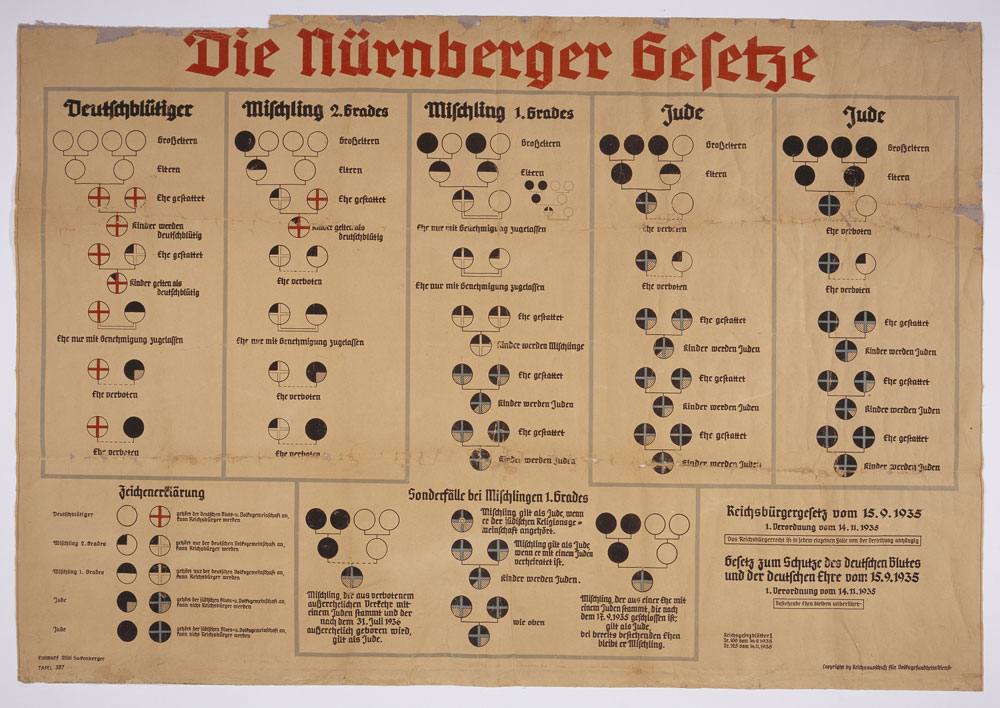
Hitler Announces Nuremberg Race Laws
At their annual party rally, Nazi leaders announced new laws that defined Jews as a “race” and stripped them of basic citizenship rights.
View newspaper articlesThe German government decreed the Nuremberg Race Laws (Reich Citizenship Law and Law for the Protection of German Blood and German Honor) on September 15, 1935. The laws were passed during a special session of the Nazi-controlled Reichstag at the Party’s rally in Nuremberg, Germany.
These laws institutionalized many of the racial theories underpinning Nazi ideology, and provided the legal framework for the systematic persecution of Jews in Germany. The laws excluded Jews from Reich citizenship and prohibited them from marrying or having sexual relations with persons of “German or German-related blood.” Ordinances supporting these laws deprived German Jews of most political entitlements, including the right to vote or hold public office.
These laws represented a major shift from traditional antisemitism, which defined Jews by religious belief, to a conception of Jews as members of a race, defined by blood and by lineage. For this reason, the Nuremberg Race Laws did not identify a “Jew” as someone with particular religious convictions, but instead as someone with three or four Jewish grandparents. Many Germans who had not practiced Judaism or who had not done so for years found themselves caught in the grip of Nazi terror. Even people with Jewish grandparents who had converted to Christianity could be defined as Jews.
On November 14, 1935, the first supplemental decree of the Nuremberg Laws extended the prohibition to marriage or sexual relations between people who could produce "racially suspect" offspring. A week later, the Minister of the Interior interpreted this to mean relations between "those of German or related blood" and Roma (Gypsies), blacks, or their offspring.
Learn More about this Historical Event
- Nuremberg Race Laws: Background (Encyclopedia Article)
- Nuremberg Race Laws: Translation (Encyclopedia Article)
- The Nuremberg Race Laws (The Holocaust: A Learning Site for Students)
- Anti-Jewish Legislation in Pre-War Germany (Encyclopedia Article)
- Racism (Encyclopedia Article)
Bibliography
Burleigh, Michael, and Wolfgang Wippermann. The Racial State: Germany 1933–1945. Cambridge: Cambridge University Press, 1991.
Edelheit, Abraham J., and Hershel Edelheit. "Legislation, Anti-Jewish." In History of the Holocaust: A Handbook and Dictionary, pp. 299–331. Boulder, CO: Westview Press, 1994.
Friedländer, Saul. Nazi Germany and the Jews. New York: HarperCollins, 1997.
Mosse, George L. Toward the Final Solution: A History of European Racism. Madison: University of Wisconsin Press, 1985.
Schleunes, Karl A. The Twisted Road to Auschwitz: Nazi Policy Toward German Jews, 1933–1939. Urbana: University of Illinois Press, 1970.
Wistrich, Robert S. Antisemitism: The Longest Hatred. London: Thames Methuen, 1991.
Search tips
These dates and keywords are associated with this historical event.